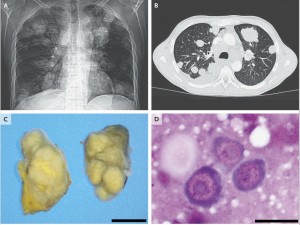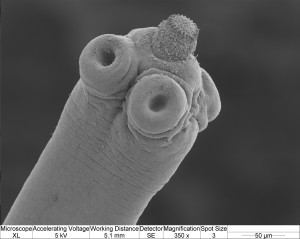Parasites are some of the oldest and basic forms of life on the planet. Each and every species having honed their specific traits to leech and infest their host often through millions of years of natural selection. It’s a scary thought, to say the least. And one particular widespread parasitic species has recently been discovered to have made significant jump. Tapeworms.
It’s a certain parasite that I’m quite concerned about every time I pick up an egg sandwich at local gas station. Tapeworms often infest the digestive tract of animals and use their hosts are intermediary stages in their life cycle. In the case of humans, that infection is usually caused by consuming undercooked foods. The photo of a vomited tapeworm above was taken from a pregnant 26-year-old patient who had been living in East Africa. As you can see, they can grow immensely large in your intestine without any symptoms (one of the optimal traits of a model parasite).
If that wasn’t enough to make your skin crawl, a study published in 1999 found that up to 75 million people may carry the dwarf tapeworm with 25% of children affected in certain areas. When taking a much closer look with an electron microscope (image below), you can clearly see that tapeworms have an effective adaption on its head: suckers, muscular grooves, and hooks to latch onto your inner digestive system. Though rarely lethal, newly published research has uncovered a potentially deadly link between these worms and cancer.
A brief report was published this past week in the New England Journal of Medicine, detailing an unprecedented case of a tapeworm (or any parasite of that matter) transferring cancer cells into a human. The team of American researchers led by Dr. Atis Muehlenbachs from the Centers for Disease Control and Prevention claim it to be the first reported case of its kind. Easing public fears, it’s also been described as extremely unusual and rare.
The story begins in Columbia in 2013 when a 41-year-old man stumped local doctors of his deteriorating condition. He was ill, losing weight, and struggling with a prior HIV infection. Upon further examination, a CT scan of his lungs showed many tumorous growths which were made of cells not identified as human. That shocking revelation prompted them to contact scientists at the U.S. CDC.

Figure 1 (A). Radiographic and Pathological Features of Malignant Hymenolepis nana.
(Muehlenbachs et al. 2015)
Source: The New England Journal of Medicine
The CDC center in Atlanta found the cells to be much smaller than human ones. Ten times smaller. Eventually, a genetic analysis found the strange cells had DNA from Hymenolepis nana (the dwarf tapeworm). The current theory is that the HIV patient’s compromised immune system and a mutation in the tapeworm caused this spread of cancerous cells from parasite to host. For a more detailed explanation of the biological mechanisms involved, check out the helpful video below courtesy of the New England Journal of Medicine.

It’s important to note that original patient died before he was correctly diagnosed. However, perhaps the results of this investigation may prove to be fruitful for others in the future as millions of people suffer from both tapeworms and HIV.
Tragedy aside, one has to admire how amazing this discovery is. For myself, I’m so impressed by the international collaboration of medical experts as well as the nature of the case. Even the language used in the original paper sounds very dramatic, “Invasion of human tissue by abnormal, proliferating, genetically altered tapeworm cells is a novel disease mechanism that links infection and cancer.” (*I’ve underlined some phrases to emphasize their impact.)
It feels like something out of the TV show House MD: a medical mystery, bizarre clues, the elusive search, and the extraordinary resolution. It’s the kind of passion that I believe Muehlenbachs shares.
“We were amazed when we found this new type of disease – tapeworms growing inside a person, essentially getting cancer, that spread to the person, causing tumor…” – Dr. Atis Muehlenbachs of the U.S. CDC
Furthermore, I’m sure this case will spark a new field in medical research of cross-species oncology. I admit that this mutation may not be very beneficial to the tapeworm as it prematurely kills off its human host and may end up being a once-in-a-life phenomenon. Nonetheless, it’s a great example of how a parasite can dramatically change the relationship with its host and how we should approach treatment of unknown diseases.
By Paul Yi
Commented on:
Esther Lo’s Green Rush in Canada
Matthew Golf’s Free Speech for Science in Canada
Luxi Xu’s Work-Life Balance



